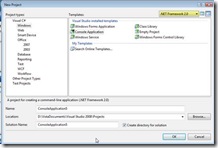Contents tagged with .NET 3.5
-
DTOGenerator: Easily Generate Data Transfer Objects from ADO.NET Entity Framework or LINQ to SQL Data Classes
In my previous post I wrote about a small utility that automatically generates Data Transfer Objects from LINQ to SQL Data Classes. Few days ago I had the time to add an important feature – the application can now generate DTO’s from ADO.NET Entity Framework Model as well. I also renamed the application to DTOGenerator and published it in CodePlex.
-
an Open Source Utility that Automatically Create Data Transfer Objects based on LINQ to SQL Data Classes
Few weeks ago I posted in my Hebrew blog a post about using Data Transfer Objects to work with LINQ to SQL and ADO.NET Entity Framework (that currently both of them doesn’t support working with POCO).
One of the comments I got was that using DTO’s takes twice the time than not using them. That’s because you have to write DTO class for each entity and you also have to write method in the DTO class that return the DAL object (the object created by the ORM and mapped to a table in the DB) from the DTO and vice-versa. -
How-To: Use ClickOnce to deploy your Applications
CickeOnce, is a technology for deploying smart-client applications. When we talk about smart-client application that deployed with ClickOnce, we want that the application will:
-
Dynamic Data Web Application - Part 1
ASP.NET 3.5 Extensions is a package of new controls and tools that improve the existing ASP.NET 3.5.
One of the interesting (and time-saving) features, is the Dynamic Data Controls. Dynamic Data Controls can be used to build easily, almost without writing any line of code a complete data-driven Web Application.
The controls cover the common things that developers use when build a web application which work with DB - view information, delete, update, view detailed information, add new data etc. -
Use C# 3 features from C# 2 and .NET 2.0 code (var keyword, anoynoymous types, auto-properties and more from .NET 2.0 project)
 Visual Studio 2008 and .NET 3.5 are already here, but some of us, sometimes, still need to use .NET 2.0.
Visual Studio 2008 and .NET 3.5 are already here, but some of us, sometimes, still need to use .NET 2.0.
Visual Studio 2008, support in a new feature called “Multi Targeting”. You can use Visual Studio 2008 ad IDE for .NET 2.0 and .NET 3.0 too. Simply, in the “New Project” form, choose the version you want.